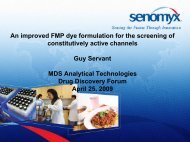Dutch Boltz - Molecular Devices
Dutch Boltz - Molecular Devices
Dutch Boltz - Molecular Devices
Create successful ePaper yourself
Turn your PDF publications into a flip-book with our unique Google optimized e-Paper software.
Abstract<br />
Ion channels are an attractive class of drug targets because of their involvement in a diverse range of<br />
cardiovascular, inflammatory, and neurological disorders. Their pharmacological complexity proves<br />
advantageous for developing highly selective drugs that affect only specific functional states of the channel.<br />
Advancements in fluorescent dyes and optical detection technologies have provided drug discovery programs<br />
with functional screening assays capable of detecting ion channel modulation in an HTS format. We have<br />
developed a membrane potential kinetics screen for a FLIPR-384 instrument that utilizes a FRET-based<br />
coumarin-DiSBAC 2<br />
dye system to screen inhibitors of ion channel X expressed in HEK293 cells. We have<br />
modified a FLIPR-384 instrument with a 409nm krypton laser, introducing the beam co-linear to the 488nm<br />
argon laser path by additional beam steering optics in order to overcome limitations which previously<br />
restricted the use of such FRET based dyes on FLIPR . A number of channel X specific compounds were<br />
screened on the modified FLIPR-384 and compared to results generated on the standard kinetic plate reader.<br />
There was good correlation between both systems for all tested compounds. The modified FLIPR had a<br />
slightly increased sensitivity and a 12-24 factor increase in throughput. Running this assay in ratiometric<br />
mode on FLIPR, reading all 384 wells simultaneously, eliminates the run-down of signal and variability<br />
observed on the other plate reader. These findings demonstrate the feasibility of using a modified FLIPR-384<br />
as an HTS platform utilizing FRET based voltage sensors to identify novel ion channel modulators.<br />
Additionally, the same configuration with an argon-krypton laser substitution for the argon primary laser<br />
would permit the use of virtually any dye on FLIPR with the possibility of simultaneously following two<br />
distinct physiological sensors .<br />
Introduction<br />
Historically, ion channel HTS assays have taken the form of membrane potential or calcium flux population<br />
kinetics. More recent approaches have shifted toward the use of membrane potential sensitive fluorophores<br />
that undergo redistribution within the plasma membrane in response to voltage changes. One such approach<br />
makes use of DiSBAC 4<br />
, or a similar single excitation, single emission dye to measure time courses greater than<br />
10 seconds. A more rapid technique was later developed that utilizes a Coumarin-DiSBAC 2<br />
FRET dye pair to<br />
deal with time courses less than 10 seconds. It has the distinct advantage of functioning as a ratiometric dye<br />
with increased temporal resolution, reproducibility and throughput; advancing measurements beyond the<br />
detection of steady-state changes in membrane potential and avoiding the need for pharmacological<br />
6/14/2004 Cardiovascular Diseases 23<br />
modification of rapidly inactivated or desensitized ion channels.
















